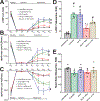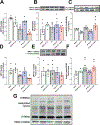Cardioprotective Action of a Novel Synthetic 19,20-EDP Analog Is Sirt Dependent
- PMID: 38180457
- PMCID: PMC10770468
- DOI: 10.1097/FJC.0000000000001495
Cardioprotective Action of a Novel Synthetic 19,20-EDP Analog Is Sirt Dependent
Abstract
Mounting evidence suggests that cytochrome P450 epoxygenase-derived metabolites of docosahexaenoic acid, called epoxydocosapentaenoic acids (EDPs), limit mitochondrial damage after cardiac injury. In particular, the 19,20-EDP regioisomer has demonstrated potent cardioprotective action. Thus, we investigated our novel synthetic 19,20-EDP analog SA-22 for protection against cardiac ischemia-reperfusion (IR) injury. Isolated C57BL/6J mouse hearts were perfused through Langendorff apparatus for 20 minutes to obtain baseline function, followed by 30 minutes of global ischemia. Hearts were then treated with vehicle, 19,20-EDP, SA-22, or SA-22 with the pan-sirtuin inhibitor nicotinamide or the SIRT3-selective inhibitor 3-(1H-1,2,3-triazol-4-yl) pyridine (3-TYP) at the start of 40 minutes reperfusion (N = 5-8). We assessed IR injury-induced changes in recovery of myocardial function, using left ventricular developed pressure and systolic and diastolic pressure change. Tissues were assessed for electron transport chain function, SIRT1 and SIRT3, optic atrophy type 1, and caspase-1. We also used H9c2 cells in an in vitro model of hypoxia/reoxygenation injury (N = 3-6). Hearts perfused with SA-22 had significantly improved postischemic left ventricular developed pressure, systolic and diastolic recovery (64% of baseline), compared with vehicle control (15% of baseline). In addition, treatment with SA-22 led to better catalytic function observed in electron transport chain and SIRT enzymes. The protective action of SA-22 resulted in reduced activation of pyroptosis in both hearts and cells after injury. Interestingly, although nicotinamide cotreatment worsened functional outcomes, cell survival, and attenuated sirtuin activity, it failed to completely attenuate SA-22-induced protection against pyroptosis, possibly indicating EDPs exert cytoprotection through pleiotropic mechanisms. In short, these data demonstrate the potential of our novel synthetic 19,20-EDP analog, SA-22, against IR/hypoxia-reoxygenation injury and justify further development of therapeutic agents based on 19,20-EDP.
Copyright © 2023 Wolters Kluwer Health, Inc. All rights reserved.
Conflict of interest statement
The authors report no conflicts of interest.
Figures






References
-
- Lopez AD, Adair T. 2019. Is the long-term decline in cardiovascular-disease mortality in high-income countries over? Evidence from national vital statistics net. International Journal of Epidemiology. 48(6):1815–1823. - PubMed
-
- Timmis A, Vardas P, Townsend N, Torbica A, Katus H, De Smedt D, Gale CP, Maggioni AP, Petersen SE, Huculeci R et al. 2022. European society of cardiology: Cardiovascular disease statistics 2021. European heart journal. 43(8):716–799. - PubMed
-
- Ibanez B, James S, Agewall S, Antunes MJ, Bucciarelli-Ducci C, Bueno H, Caforio ALP, Crea F, Goudevenos JA, Halvorsen S et al. 2018. 2017 esc guidelines for the management of acute myocardial infarction in patients presenting with st-segment elevation. European Heart Journal. Oxford University Press. p. 119–177. - PubMed
-
- Neumann FJ, Sousa-Uva M, Ahlsson A, Alfonso F, Banning AP, Benedetto U, Byrne RA, Collet JP, Falk V, Head SJ et al. 2019. 2018 esc/eacts guidelines on myocardial revascularization. European Heart Journal. Oxford University Press. p. 87–165. - PubMed
Publication types
MeSH terms
Substances
Grants and funding
LinkOut - more resources
Full Text Sources

